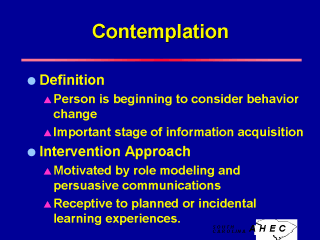| front |1 |2 |3 |4 |5 |6 |7 |8 |9 |10 |11 |12 |13 |14 |15 |16 |review |
 |
Contemplation It is during this stage that individuals begin to think about making a change related to their health. Some 40% of people are also in this stage, just as 40% are precontemplators, but these are dealing with extreme ambivalence. Contemplators are beginning to see more “pro’s” in making a change than “con’s”. Information related to their health may begin to influence them more in this stage than previously. They begin to collect cues and messages that begin to increase their receptivity to change. In other words they may begin to see that eating a better diet could pay off for them because they would look better and feel healthier whereas earlier, they just wanted to enjoy eating high calorie foods. For contemplators, a life event such as turning 39 or an illness may begin a shift in their thinking that encourages them to take steps toward change. These people may go through a lengthy series of changes before moving more toward preparation and action. Unless interventions are tried with contemplators, they may get stuck at this stage for a couple of years. They are often referred to as chronic contemplators or procrastinators.When working with contemplators we must help them to lower their perception of the “cons”, or perceived barriers to change, if they are going to be prepared to change. . |